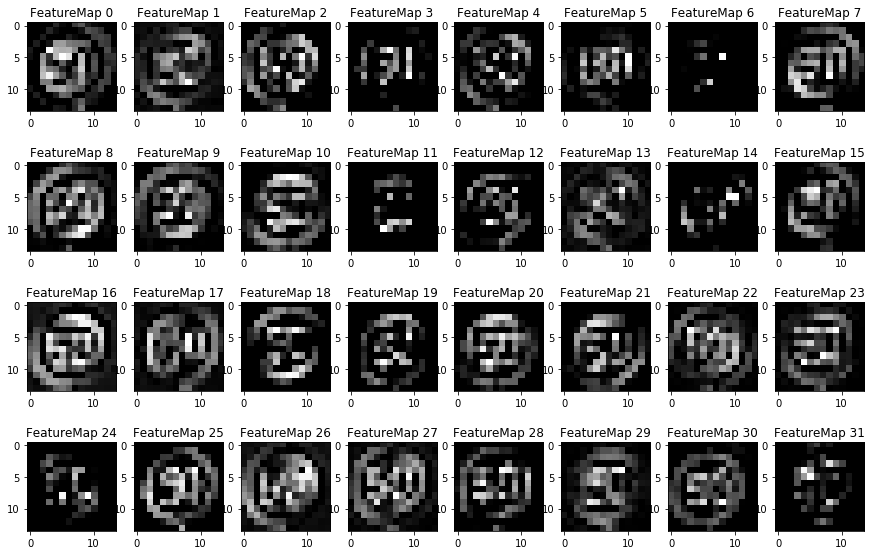Traffic Sign Classification
Load Data
Load the MNIST data, which comes pre-loaded with TensorFlow.
# Load pickled data
import pickle
import numpy as np
training_file = 'train.p'
validation_file = 'valid.p'
testing_file = 'test.p'
with open(training_file, mode='rb') as f:
train = pickle.load(f)
with open(validation_file, mode='rb') as f:
valid = pickle.load(f)
with open(testing_file, mode='rb') as f:
test = pickle.load(f)
X_train, y_train = train['features'], train['labels']
X_validation, y_validation = valid['features'], valid['labels']
X_test, y_test = test['features'], test['labels']
assert(len(X_train) == len(y_train))
assert(len(X_validation) == len(y_validation))
assert(len(X_test) == len(y_test))
n_train = len(X_train)
n_validation = len(X_validation)
n_test = len(X_test)
image_shape = X_train[0].shape
n_classes = len(np.unique(y_train))
print("Number of training examples =", n_train)
print("Number of testing examples =", n_test)
print("Image data shape =", image_shape)
print("Number of classes =", n_classes)
Number of training examples = 34799
Number of testing examples = 12630
Image data shape = (32, 32, 3)
Number of classes = 43
Visualize Data
View a sample from the dataset.
You do not need to modify this section.
import random
import matplotlib.pyplot as plt
import matplotlib.image as mpimg
%matplotlib inline
index = 15706 # random.randint(0, len(X_train))
image = X_train[index].squeeze()
plt.figure(figsize=(2,2))
plt.imshow(image)
plt.show()
print(y_train[index])
is_features_normal = False

38
Data Augmentation
Functions to Rotate, Scale, Transform, Blur and Normalize existing Data
from scipy import ndimage
import cv2
def rotate(img):
rows,cols,_ = img.shape
axis_offset = random.uniform(-2,2)
angle = random.uniform(-10,10)
scale = random.uniform(0.95,1.05)
M = cv2.getRotationMatrix2D((cols/2 + axis_offset,rows/2 + axis_offset),angle,scale)
dst = cv2.warpAffine(img,M,(cols,rows))
return np.reshape(dst,(32,32,1))
def affine_transform(img):
rows,cols,_ = img.shape
off = 4
x_pt1 = np.array([cols/2, cols/4, 3*cols/4])
y_pt1 = np.array([rows/4, 3*rows/4, 3*rows/4])
x_offset = (np.random.rand(3) - 0.5) * off
y_offset = (np.random.rand(3) - 0.5) * off
x_pt2 = x_pt1 + x_offset
y_pt2 = y_pt1 + y_offset
pt1 = list(map(list, zip(*np.vstack((x_pt1, y_pt1)))))
pt2 = list(map(list, zip(*np.vstack((x_pt2, y_pt2)))))
pts1 = np.float32(pt1)
pts2 = np.float32(pt2)
M = cv2.getAffineTransform(pts1,pts2)
dst = cv2.warpAffine(img,M,(cols,rows))
return np.reshape(dst,(32,32,1))
def perspect(img):
rows,cols,_ = img.shape
off = 4
x_pt1 = np.array([0, cols, 0, cols])
y_pt1 = np.array([0, 0, rows, rows])
x_offset = (np.random.rand(4) - 0.5) * off
y_offset = (np.random.rand(4) - 0.5) * off
x_pt2 = x_pt1 + x_offset
y_pt2 = y_pt1 + y_offset
pt1 = list(map(list, zip(*np.vstack((x_pt1, y_pt1)))))
pt2 = list(map(list, zip(*np.vstack((x_pt2, y_pt2)))))
pts1 = np.float32(pt1)
pts2 = np.float32(pt2)
M = cv2.getPerspectiveTransform(pts1,pts2)
dst = cv2.warpPerspective(img,M,(32,32))
return np.reshape(dst,(32,32,1))
def gaus_blur(img):
kernel = np.ones((2,2),np.float32)/4
dst = cv2.filter2D(img,-1,kernel)
return np.reshape(dst,(32,32,1))
def eq_hist(img):
img = np.reshape(img,(32,32)).astype('uint8')
dst = cv2.equalizeHist(img)
return np.reshape(dst,(32,32,1)).astype('float')
def normalize(image_data):
return (image_data - 128)/ 128
Convert to Grayscale
X_train_gray = np.mean(X_train, axis=3, keepdims=True)
X_test_gray = np.mean(X_test, axis=3, keepdims=True)
X_validation_gray = np.mean(X_validation, axis=3, keepdims=True)
Visualizing the Data Augmentation Output
index = 15706 #random.randint(0, len(X_train_gray))
image = X_train_gray[index].squeeze()
print(image.shape)
plt.figure(figsize=(2,2))
plt.imshow(image, cmap="gray")
plt.show()
print(y_train[index])
image1 = eq_hist(gaus_blur(affine_transform(perspect(X_train_gray[index]))))
print(type(image))
print(image1.shape)
plt.figure(figsize=(2,2))
plt.imshow(image1.squeeze(), cmap="gray")
plt.show()
(32, 32)

38
<class 'numpy.ndarray'>
(32, 32, 1)
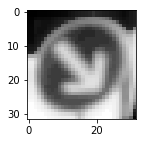
Visualizing the Number of Training examples under each Label
Note that for few labels, we have very less data to train our model. This will result in lower prediction accuracy for those labels. Thus we will first augment our Data to atleast the mean of number of examples for each label.
def plot_bar(data):
count_sample = []
for i in range(43):
count_sample.append(sum(data == i))
plt.figure(figsize=(15,7))
plt.bar(np.arange(43), np.array(count_sample))
return count_sample
count = plot_bar(y_train)
mean = np.mean(count)
print(mean)
labels_below_mean = np.arange(43)[np.array(count) < np.mean(count)]
809.279069767

X_augmented = []
y_augmented = []
for l in labels_below_mean:
X_to_augment = X_train_gray[y_train == l]
repeat = int(mean / X_to_augment.shape[0])
for r in range(repeat):
for im in range(X_to_augment.shape[0]):
X_augmented.append(eq_hist(gaus_blur(affine_transform(perspect(X_to_augment[im])))))
# X_augmented.append(random_translate(random_scaling(random_warp(random_brightness(X_to_augment[im])))))
y_augmented.append(l)
# print("Label: {} Data: {} Repeat: {}".format(l, len(X_augmented), repeat))
print(np.array(X_augmented).shape)
X_train_augmented = np.concatenate((X_train_gray, np.array(X_augmented)), axis=0)
y_train_augmented = np.concatenate((y_train, np.array(y_augmented)), axis=0)
p = plot_bar(y_train_augmented)
(16649, 32, 32, 1)

Data Normalization
if not is_features_normal:
X_train_augmented = normalize(X_train_augmented)
X_validation_gray = normalize(X_validation_gray)
X_test_gray = normalize(X_test_gray)
is_features_normal = True
index = random.randint(0, X_train_augmented.shape[0])
image = X_train_augmented[index].squeeze()
# plt.figure(figsize=(2,2))
plt.imshow(image, cmap='gray')
plt.show()
print(y_train_augmented[index])

0
from sklearn.utils import shuffle
X_train_augmented, y_train_augmented = shuffle(X_train_augmented, y_train_augmented)
print(X_train_augmented.shape)
(51448, 32, 32, 1)
Setup TensorFlow
The EPOCH and BATCH_SIZE values affect the training speed and model accuracy.
import tensorflow as tf
EPOCHS = 30
BATCH_SIZE = 100
Model Architecture
Input
The architecture accepts a 32x32x1 image as input, since images are already converted to grayscale.
Architecture
| Layer | Description | |:———————:|:———————————————:| | Input | 32x32x1 Grayscale image | | Convolution 4x4 | 1x1 stride, valid padding, outputs 28x28x32 | | RELU | | | Max pooling | 2x2 stride, outputs 14x14x32 | | Convolution 4x4 | 1x1 stride, valid padding, outputs 10x10x128 | | RELU | | | Max pooling | 2x2 stride, outputs 5x5x128 | | Fully connected | outputs 3200x1024 | | RELU | | | Fully connected | outputs 1024x2048 | | RELU | | | Dropout | keep_prob:0.5 | | Fully connected | outputs 2048x43 | | Softmax | |
Output
Return the result of the 3rd fully connected layer.
from tensorflow.contrib.layers import flatten
l1 = 0
def LeNet(x):
global l1
mu = 0
sigma = 0.1
n_classes = 43
keep_prob = 0.5
weights = {
'wc1': tf.Variable(tf.truncated_normal(shape=[4,4,1,32],mean=mu,stddev=sigma)),
'wc2': tf.Variable(tf.truncated_normal(shape=[4,4,32,128],mean=mu,stddev=sigma)),
# 'wc21': tf.Variable(tf.truncated_normal(shape=[4,4,128,256],mean=mu,stddev=sigma)),
'wc3': tf.Variable(tf.truncated_normal(shape=[5*5*128,1024],mean=mu,stddev=sigma)),
'wc4': tf.Variable(tf.truncated_normal(shape=[1024,2048],mean=mu,stddev=sigma)),
'wc5': tf.Variable(tf.truncated_normal(shape=[2048,n_classes],mean=mu,stddev=sigma))
}
biases = {
'bc1': tf.Variable(tf.zeros(32)),
'bc2': tf.Variable(tf.zeros(128)),
# 'bc21': tf.Variable(tf.zeros(256)),
'bc3': tf.Variable(tf.zeros(1024)),
'bc4': tf.Variable(tf.zeros(2048)),
'bc5': tf.Variable(tf.zeros(n_classes))
}
pad = 'VALID'
pad_pool = 'VALID'
stride = [1,1,1,1]
k_s = [1,2,2,1]
l1 = tf.nn.conv2d(x,weights['wc1'],strides=stride,padding=pad)
l1 = tf.nn.bias_add(l1,biases['bc1'])
l1 = tf.nn.relu(l1)
l1 = tf.nn.max_pool(l1,ksize=k_s,strides=k_s,padding=pad_pool)
l2 = tf.nn.conv2d(l1,weights['wc2'],strides=stride,padding=pad)
l2 = tf.nn.bias_add(l2,biases['bc2'])
l2 = tf.nn.relu(l2)
l2 = tf.nn.max_pool(l2,ksize=k_s,strides=k_s,padding=pad_pool)
l2 = tf.contrib.layers.flatten(l2)
l3 = tf.add(tf.matmul(l2,weights['wc3']),biases['bc3'])
l3 = tf.nn.relu(l3)
l4 = tf.add(tf.matmul(l3,weights['wc4']),biases['bc4'])
l4 = tf.nn.relu(l4)
l4 = tf.nn.dropout(l4, keep_prob=keep_prob)
logits = tf.add(tf.matmul(l4,weights['wc5']),biases['bc5'])
return logits
Features and Labels
x is a placeholder for a batch of input images. y is a placeholder for a batch of output labels.
x = tf.placeholder(tf.float32, (None, 32, 32, 1))
y = tf.placeholder(tf.int32, (None))
one_hot_y = tf.one_hot(y, 43)
Training Pipeline
Create a training pipeline that uses the model to classify MNIST data.
rate = 0.0008
# global_step = tf.Variable(0, trainable=False)
# starter_learning_rate = 0.01
# learning_rate = tf.train.exponential_decay(starter_learning_rate, global_step,
# 100000, 0.96, staircase=True)
logits = LeNet(x)
cross_entropy = tf.nn.softmax_cross_entropy_with_logits(labels=one_hot_y, logits=logits)
loss_operation = tf.reduce_mean(cross_entropy)
optimizer = tf.train.AdamOptimizer(learning_rate = rate)
training_operation = optimizer.minimize(loss_operation)
Model Evaluation
Evaluate how well the loss and accuracy of the model for a given dataset.
correct_prediction = tf.equal(tf.argmax(logits, 1), tf.argmax(one_hot_y, 1))
accuracy_operation = tf.reduce_mean(tf.cast(correct_prediction, tf.float32))
saver = tf.train.Saver()
def evaluate(X_data, y_data):
num_examples = len(X_data)
total_accuracy = 0
sess = tf.get_default_session()
for offset in range(0, num_examples, BATCH_SIZE):
batch_x, batch_y = X_data[offset:offset+BATCH_SIZE], y_data[offset:offset+BATCH_SIZE]
accuracy = sess.run(accuracy_operation, feed_dict={x: batch_x, y: batch_y})
total_accuracy += (accuracy * len(batch_x))
return total_accuracy / num_examples
Train the Model
Run the training data through the training pipeline to train the model.
Before each epoch, shuffle the training set.
After each epoch, measure the loss and accuracy of the validation set.
Save the model after training.
config = tf.ConfigProto()
config.gpu_options.allow_growth = True
with tf.Session(config=config) as sess:
sess.run(tf.global_variables_initializer())
num_examples = len(X_train_augmented)
print("Training...")
print()
for i in range(EPOCHS):
X_train_augmented, y_train_augmented = shuffle(X_train_augmented, y_train_augmented)
for offset in range(0, num_examples, BATCH_SIZE):
end = offset + BATCH_SIZE
batch_x, batch_y = X_train_augmented[offset:end], y_train_augmented[offset:end]
sess.run(training_operation, feed_dict={x: batch_x, y: batch_y})
validation_accuracy = evaluate(X_validation_gray, y_validation)
print("EPOCH {} ...".format(i+1))
print("Validation Accuracy = {:.3f}".format(validation_accuracy))
print()
saver.save(sess, './lenet')
print("Model saved")
Training...
EPOCH 1 ...
Validation Accuracy = 0.868
EPOCH 2 ...
Validation Accuracy = 0.918
EPOCH 3 ...
Validation Accuracy = 0.915
EPOCH 4 ...
Validation Accuracy = 0.934
EPOCH 5 ...
Validation Accuracy = 0.929
EPOCH 6 ...
Validation Accuracy = 0.922
EPOCH 7 ...
Validation Accuracy = 0.926
EPOCH 8 ...
Validation Accuracy = 0.918
EPOCH 9 ...
Validation Accuracy = 0.946
EPOCH 10 ...
Validation Accuracy = 0.956
EPOCH 11 ...
Validation Accuracy = 0.951
EPOCH 12 ...
Validation Accuracy = 0.958
EPOCH 13 ...
Validation Accuracy = 0.954
EPOCH 14 ...
Validation Accuracy = 0.937
EPOCH 15 ...
Validation Accuracy = 0.956
EPOCH 16 ...
Validation Accuracy = 0.945
EPOCH 17 ...
Validation Accuracy = 0.964
EPOCH 18 ...
Validation Accuracy = 0.951
EPOCH 19 ...
Validation Accuracy = 0.961
EPOCH 20 ...
Validation Accuracy = 0.953
EPOCH 21 ...
Validation Accuracy = 0.956
EPOCH 22 ...
Validation Accuracy = 0.961
EPOCH 23 ...
Validation Accuracy = 0.956
EPOCH 24 ...
Validation Accuracy = 0.949
EPOCH 25 ...
Validation Accuracy = 0.960
EPOCH 26 ...
Validation Accuracy = 0.938
EPOCH 27 ...
Validation Accuracy = 0.961
EPOCH 28 ...
Validation Accuracy = 0.940
EPOCH 29 ...
Validation Accuracy = 0.954
EPOCH 30 ...
Validation Accuracy = 0.959
Model saved
Evaluate the Model on Training and Test Set
with tf.Session() as sess:
saver.restore(sess, tf.train.latest_checkpoint('.'))
train_accuracy = evaluate(X_train_augmented, y_train_augmented)
print("Training Set Accuracy = {:.3f}".format(train_accuracy))
INFO:tensorflow:Restoring parameters from ./lenet
Training Set Accuracy = 0.995
with tf.Session() as sess:
saver.restore(sess, tf.train.latest_checkpoint('.'))
test_accuracy = evaluate(X_test_gray, y_test)
print("Test Accuracy = {:.3f}".format(test_accuracy))
INFO:tensorflow:Restoring parameters from ./lenet
Test Accuracy = 0.948
Testing the model on a few more random Traffic signs
from glob import glob
my_test_images = []
for fn in glob('./mytest/*.jpg'):
im = cv2.imread(fn)
my_test_images.append(im)
my_images = np.array((my_test_images))
my_labels = np.array([2,25,40,1,33,8,14,12,0,13])
my_test_gray = np.mean(my_images, axis=3, keepdims=True)
my_test_norm = normalize(my_test_gray)
for i in range(my_images.shape[0]):
plt.subplot(5,5,i+1)
plt.imshow(my_images[i])
plt.show()










scores = tf.nn.softmax(logits)
top_scores = tf.nn.top_k(scores, k=5)
with tf.Session() as sess:
saver.restore(sess, tf.train.latest_checkpoint('.'))
my_accuracy = evaluate(my_test_norm, my_labels)
all_scores = sess.run(scores, feed_dict={x: my_test_norm})
top_five = sess.run(top_scores, feed_dict={x: my_test_norm})
print(my_accuracy)
INFO:tensorflow:Restoring parameters from ./lenet
0.899999976158
print(top_five.indices)
print(top_five.values)
[2,25,40,1,33,8,14,12,0,13]
[[ 2 1 39 29 38]
[25 24 30 11 26]
[40 12 13 38 32]
[ 1 0 2 3 4]
[33 37 39 35 21]
[ 0 1 5 40 38]
[38 14 3 17 35]
[12 0 1 2 3]
[ 0 3 6 29 16]
[13 0 1 2 3]]
[[ 1.00000000e+00 4.35791647e-27 2.04174774e-30 1.67803568e-30
2.97289868e-32]
[ 1.00000000e+00 3.81068593e-10 1.05500149e-13 9.35857693e-16
2.72417525e-17]
[ 1.00000000e+00 2.93249064e-10 2.22213456e-10 2.85895214e-11
5.93786793e-13]
[ 1.00000000e+00 0.00000000e+00 0.00000000e+00 0.00000000e+00
0.00000000e+00]
[ 1.00000000e+00 1.70946736e-31 1.09972979e-33 2.82017166e-35
2.47316632e-36]
[ 8.89052689e-01 1.08010881e-01 1.49268250e-03 9.05096065e-04
3.16681166e-04]
[ 9.99294162e-01 6.63201732e-04 3.00351949e-05 6.77168964e-06
5.73186389e-06]
[ 1.00000000e+00 0.00000000e+00 0.00000000e+00 0.00000000e+00
0.00000000e+00]
[ 9.99079943e-01 9.19892220e-04 9.28092305e-08 1.46641144e-09
1.18644441e-10]
[ 1.00000000e+00 0.00000000e+00 0.00000000e+00 0.00000000e+00
0.00000000e+00]]
[2, 25, 40, 1, 33, 8, 14, 12, 0, 13]
import csv
signs = []
with open('signnames.csv', newline='') as csvfile:
spamreader = csv.reader(csvfile, delimiter=',', quotechar='|')
for row in spamreader:
if row[0] not in 'ClassId':
signs.append(row[1])
signs = np.array(signs)
import matplotlib.pyplot as plt
for i in range(10):
fig, ax = plt.subplots()
ax.barh(np.arange(len(top_five.indices[i])), (top_five.values[i]))
ax.set_yticks(np.arange(len(top_five.indices[i])))
ax.set_yticklabels(labels=signs[top_five.indices[i]])



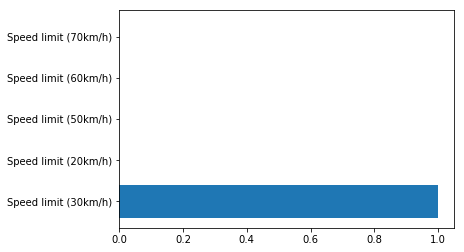
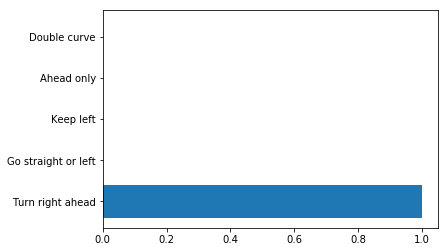
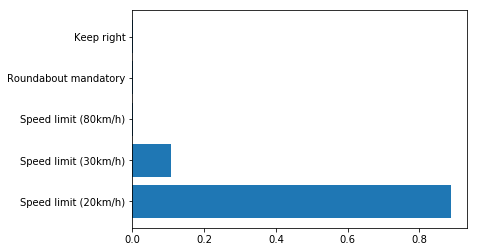
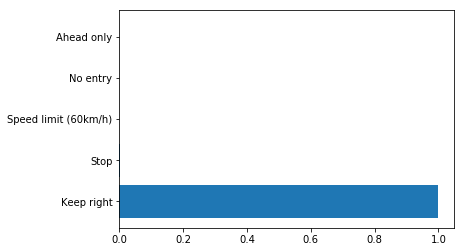

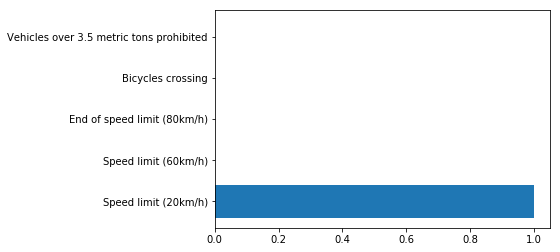
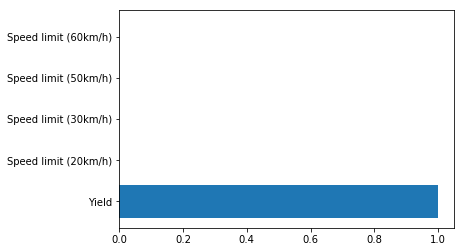
def outputFeatureMap(image_input, tf_activation, activation_min=-1, activation_max=-1 ,plt_num=1):
activation = tf_activation.eval(session=sess,feed_dict={x : image_input})
featuremaps = activation.shape[3]
plt.figure(plt_num, figsize=(15,15))
for featuremap in range(featuremaps):
plt.subplot(6,8, featuremap+1) # sets the number of feature maps to show on each row and column
plt.title('FeatureMap ' + str(featuremap)) # displays the feature map number
if activation_min != -1 & activation_max != -1:
plt.imshow(activation[0,:,:, featuremap], interpolation="nearest", vmin =activation_min, vmax=activation_max, cmap="gray")
elif activation_max != -1:
plt.imshow(activation[0,:,:, featuremap], interpolation="nearest", vmax=activation_max, cmap="gray")
elif activation_min !=-1:
plt.imshow(activation[0,:,:, featuremap], interpolation="nearest", vmin=activation_min, cmap="gray")
else:
plt.imshow(activation[0,:,:, featuremap], interpolation="nearest", cmap="gray")
with tf.Session() as sess:
saver.restore(sess, tf.train.latest_checkpoint('.'))
outputFeatureMap(my_test_norm,l1)
INFO:tensorflow:Restoring parameters from ./lenet
